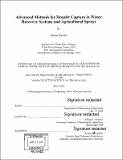Advanced methods for droplet capture in water recovery systems and agricultural sprays
Author(s)
Damak, Maher,Ph. D.Massachusetts Institute of Technology.
Download1126788537-MIT.pdf (17.33Mb)
Other Contributors
Massachusetts Institute of Technology. Department of Mechanical Engineering.
Advisor
Kripa K. Varanasi.
Terms of use
Metadata
Show full item recordAbstract
Water scarcity is one of the important challenges of our century. In this thesis, we investigate advanced methods to mitigate it in two ways: water recovery from fog and reducing chemicals runoff in agriculture. In the first part, we review current fog collector design and identify droplet deviation around the wires of mesh collectors as the main bottleneck in water collection. We introduce an electrostatic force to overcome aerodynamic drag around the collector, using space-charge injection into the fog droplets and an electric field that drives them to the collector. We quantitatively model the collection and show that it scales from a one-wire system to a mesh. We demonstrate increases of up to 50X in collection efficiency, and show that various geometries and designs can be used. In particular, we propose the usage of this method to capture water from industrial condensation plumes. We model these plumes by taking into account the mixing dynamics between vapor and air and the heat transfer dynamics for droplet growth. Based on this model, we provide design guidelines for effective plume collectors. In the second part, we aim to enhance the retention of droplets on hydrophobic surfaces to reduce bouncing losses when pesticides are sprayed. We review current methods to retain impacting droplets and identify their limitations. We introduce simultaneous spraying of oppositely charged polyelectrolytes as a new method to enhance retention. We show that in a drop-on-drop impact with polyelectrolytes, a precipitation reaction occurs and surface defects are formed in-situ. These defects pin the retracting droplet and prevent it from bouncing. We quantify the energy dissipation by pinning and make a design map for sticking sprays. We show a 1OX increase in retention and coverage of various superhydrophobic surfaces. To refine our model, we then systematically study drop-on-drop impacts on non-wetting surfaces and model the maximal expansion diameter and retraction rate based on the interplay of inertia, viscosity and capillarity. We finally study the case where the sprayed liquid is an oil-in-water emulsion. We show that there is a bouncing-sticking-bouncing transition in emulsion impacts as the Weber number increases. We demonstrate that, for low enough viscosities, oil impregnates the surface under the droplet during impact and generates a suction force that prevents bouncing. We then provide the optimal parameters for which the retention can be enhanced, to guide the preparation of effective agricultural sprays.
Description
Thesis: Ph. D., Massachusetts Institute of Technology, Department of Mechanical Engineering, 2018 Cataloged from PDF version of thesis. Includes bibliographical references (pages 161-181).
Date issued
2018Department
Massachusetts Institute of Technology. Department of Mechanical EngineeringPublisher
Massachusetts Institute of Technology
Keywords
Mechanical Engineering.